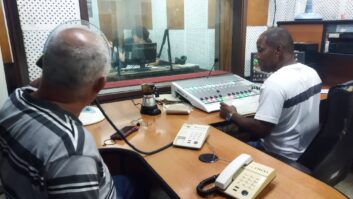SANTIAGO, CHILE — Radio Agricultura is a leading Chilean radio network that has been operating for over 75 years. It is a 100-percent live, with current affairs, sports and, above all, entertainment radio. We cover all of Chile in FM and AM through a large radio station network.

The phone system’s software controller user interface can be seen on the screen.
We have used all three generations of AEQ multi-conference telephone systems. Back in 2001 we installed AEQ Systel 3000, based on phone hybrids. In 2008, we deployed an AEQ Systel 6000 to achieve central management of all incoming and outgoing calls related to the programs produced in the company. It was based on digital ISDN technology but also enabled to make use of analog lines.
Now, as Radio Agricultura moves to a completely revamped building, we are betting on AEQ’s third-generation multi-conference system: Although AEQ Systel 6000 remains fully operational in the new studios, working mainly on analog lines, the installation has been completed with a new Systel IP 12 platform. It allows for the touchscreen management of up to 12 simultaneous IP calls, dynamically distributed for the three on-air studios.
DIFFERENT
Leaving apart the fact that, so far, testing a new AEQ piece of equipment has always been a success, in this case we have been pleasantly surprised by some differentiating Systel IP features.
Systel IP allows for the connection of broadcast telephony to current, IP-based, corporate PBXes. This way, maintaining conventional lines exclusively for broadcasting is no longer required. As an example, before the Systel IP, when a call for an editor was coming in through our Cisco PBX and it was deemed as interesting to air the call, we had to take note of the incoming number, and then call control and instruct the producer there to dial it. This was always assuming the risk of an error when noting the number or that the caller would be busy, so an important guest could be missed or lost.
Systel IP is integrated with Cisco Call Manager, and calls can be transferred from any extension in the phone system to Systel IP, which acts as a multi-line telephone with 12 extensions. This also means that we can benefit from advantageous IP telephony fees, instead of paying the cost of hiring ISDN phone lines, which are becoming more and more expensive as they are getting quite difficult to obtain.
Another advantage resides in the user’s interface. The workflow is quite user-friendly. We can call from the system’s onboard phone book or from an auxiliary phone. Calls can be received and when the caller’s information is stored in the phone book, its name appears on the screen. Otherwise, the producer can still label it and simultaneously type some comments in a special field in the screen that is duplicated on the controller’s PC and in the studio. Once labeled, the call can be put on hold while listening to the program into a playout queue, or left waiting for further instructions. A counter tells us how long this call has been waiting from the last time we spoke to the caller.
Besides, a chat is available between the producer, controller and presenter in order to better organize the show.
The phone book allows us to prepare a list of calls to make during a program. Annoying numbers can be placed in a black list, so when they call, a busy tone is returned and the call is disconnected. Previous calls can be cleared from the line before starting a phone quiz or contest.
Individual programs can maintain separate private phone number lists, avoiding the spreading of “sensitive” phone numbers corresponding to important people.
In simple programs, lines are shared between the studios in a more or less balanced way, as a function of the traffic in each studio and program.
The system also provides many advantages to the controllers. Input and return levels can be defined for each of the studio phone lines and temporary or permanent adjustments can also be applied to each one. In addition, an automatic gain control can be enabled, letting the equipment take care of the input level according to the characteristics of each line and the sound volume of the incoming voices.
Calls can be queued on one or several faders, allowing for great flexibility when putting them on air. Further, several interlocutors can be on air, even all 12 at the same time — provided that they are well-trained not to talk at the same time. Even in this case, it is simple to push or move someone that is interrupting others aside, talk to him/her privately and then return him/her to the discussion.
For all these reasons we are delighted with this third generation of AEQ talk show systems. If the former generation provided a substantial improvement in communications quality, this one has supposed a big leap in regards to operational convenience that pleases producers, controllers and presenters. Also from the technical and management points of view, the flexibility and communications savings provided by the system are remarkable.
Integration with the company’s phone system was remotely prepared, but as this had to be done at the same time as a large equipment installation, we were lucky to count on AEQ technical services in situ not only during the configuration and start-up phases of the system but also for the system’s installation and training.
For information, contact Peter Howarth at AEQ Broadcast International in Florida at 800-728-0536 or visit www.aeqbroadcast.com.










